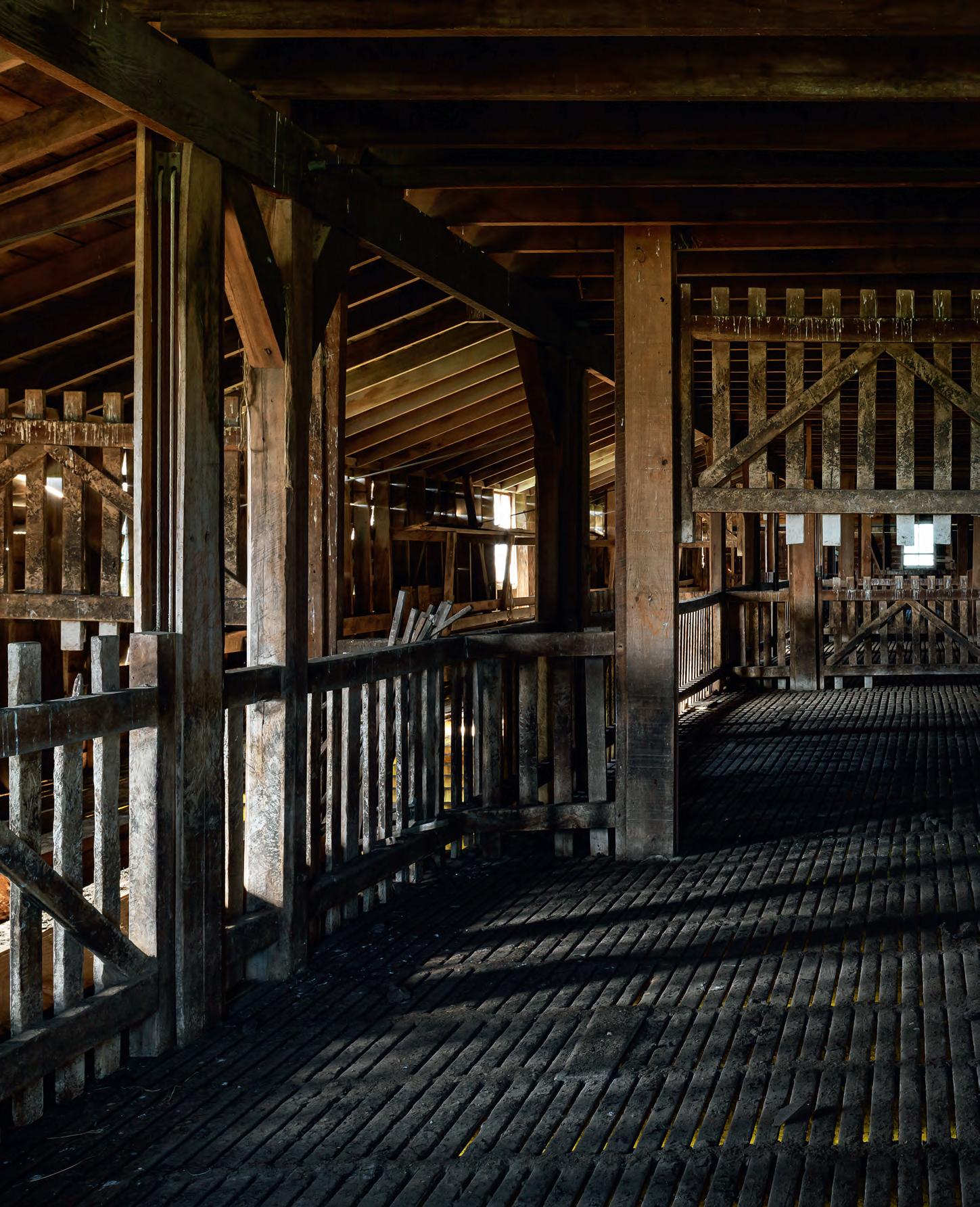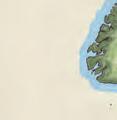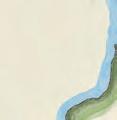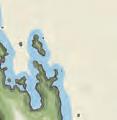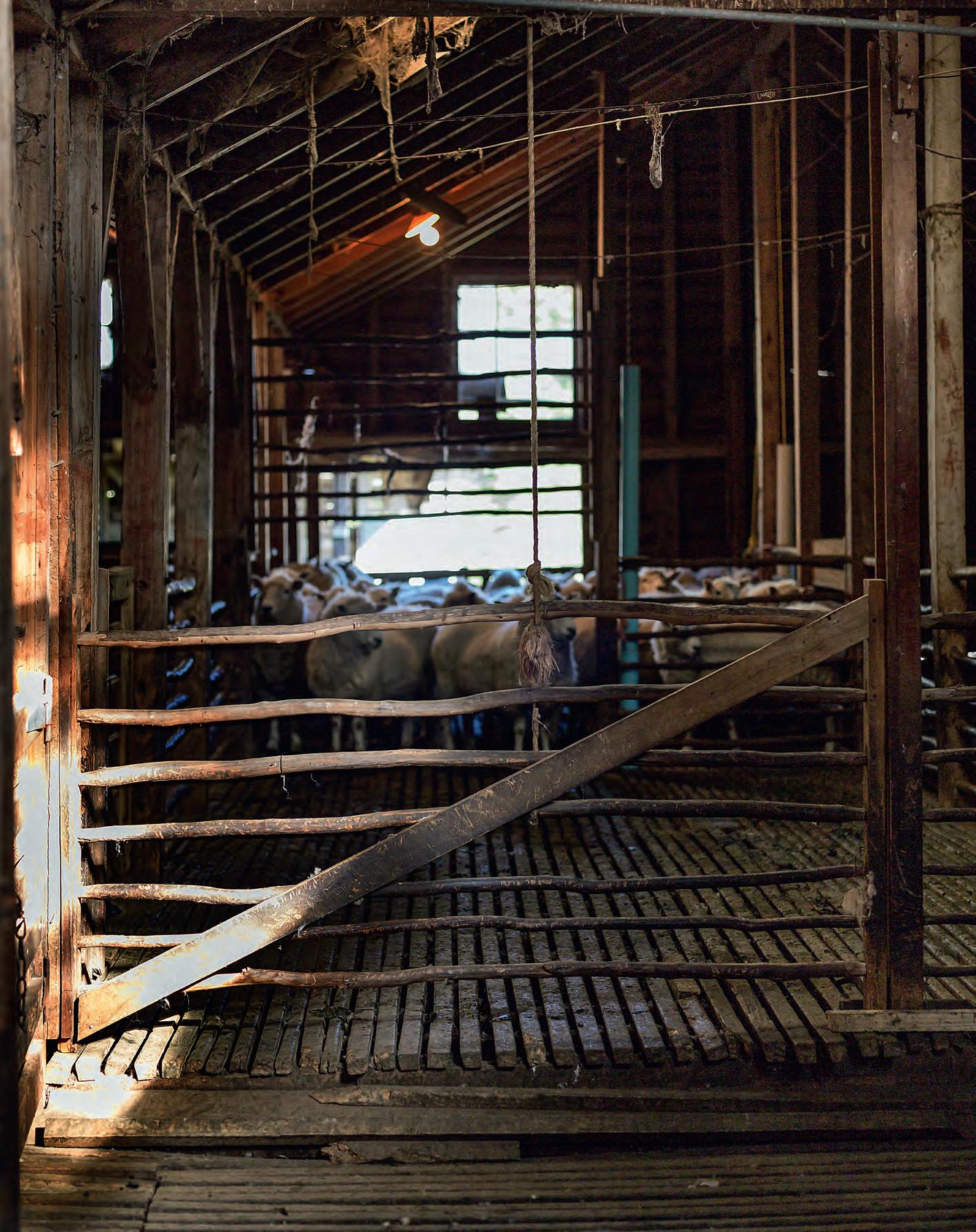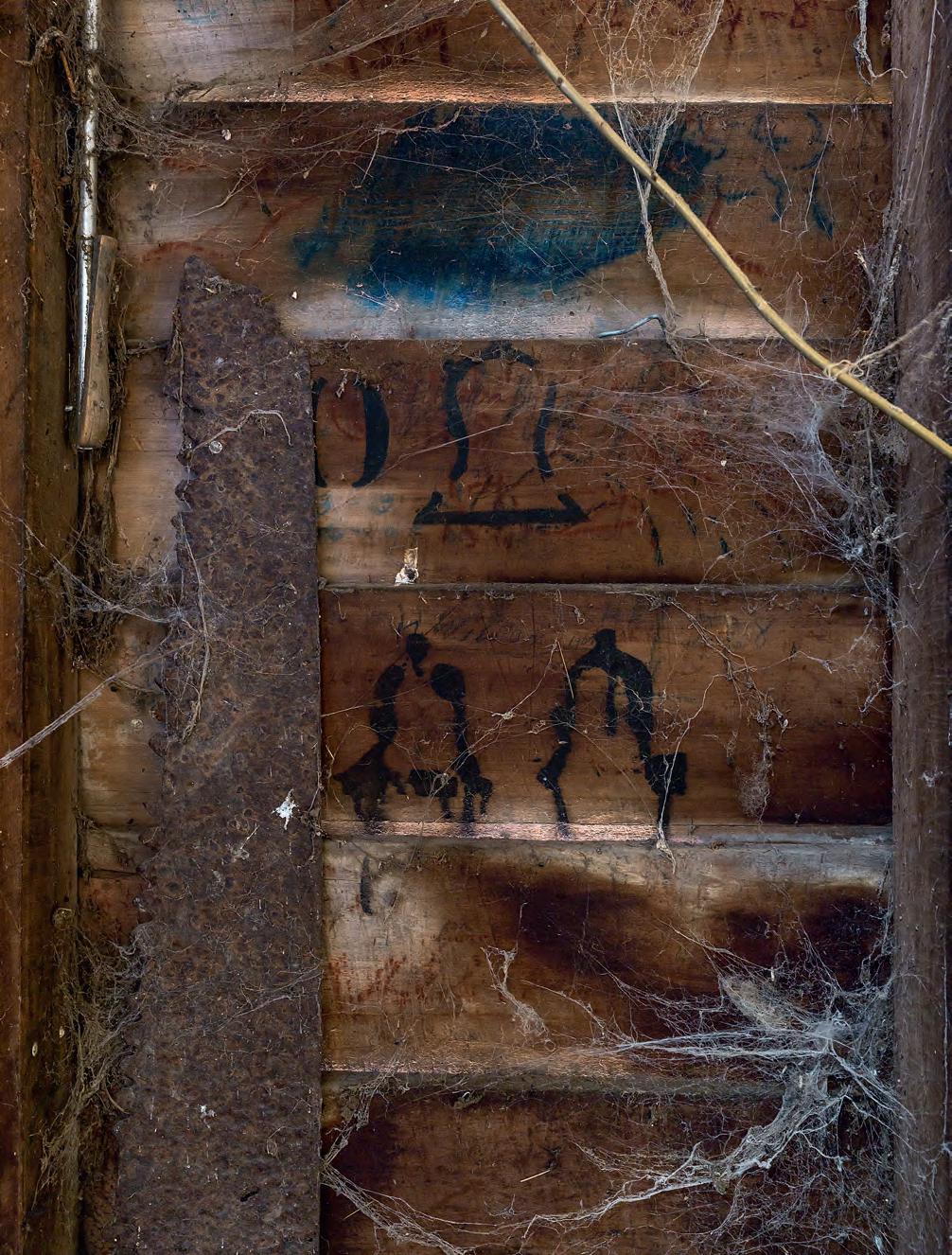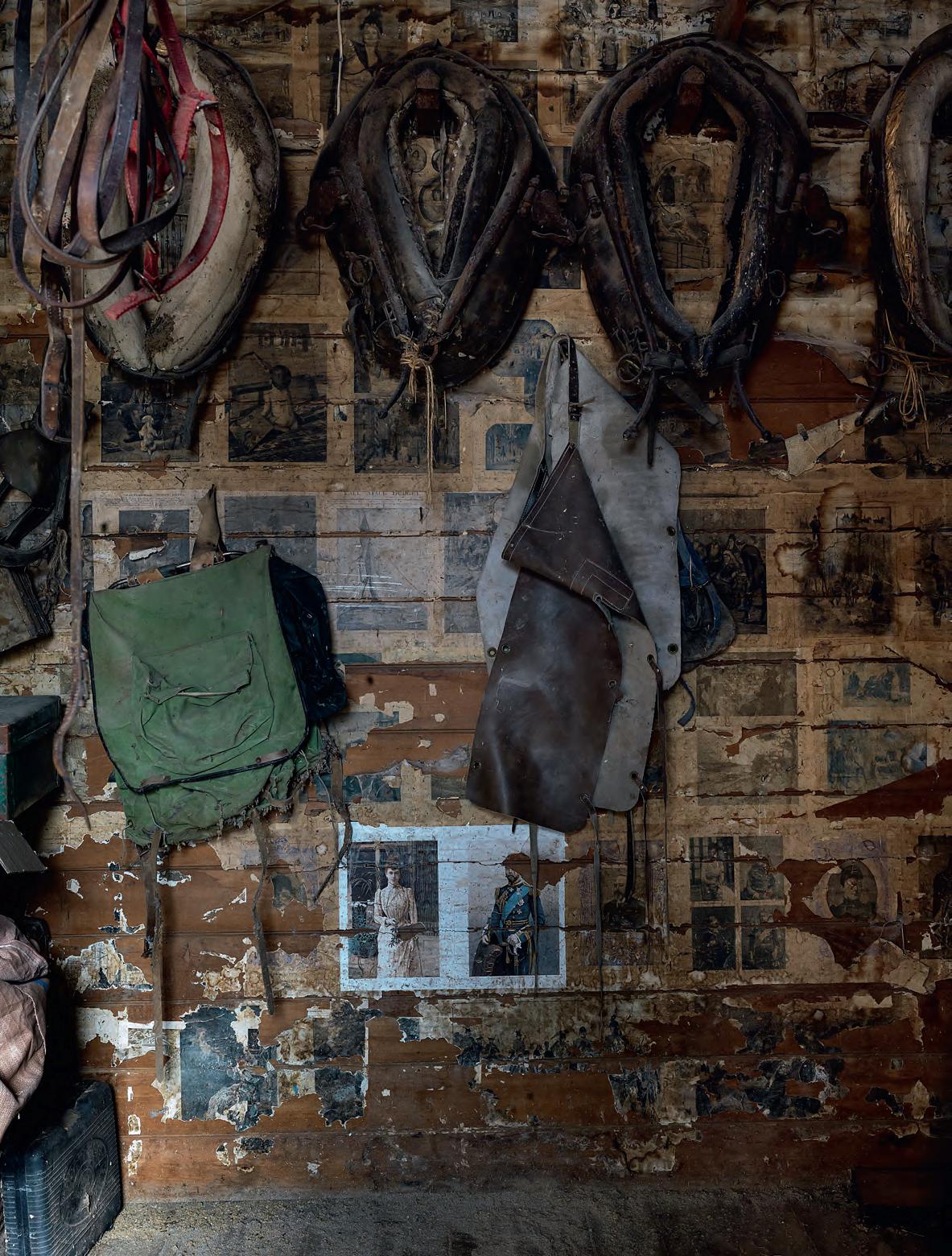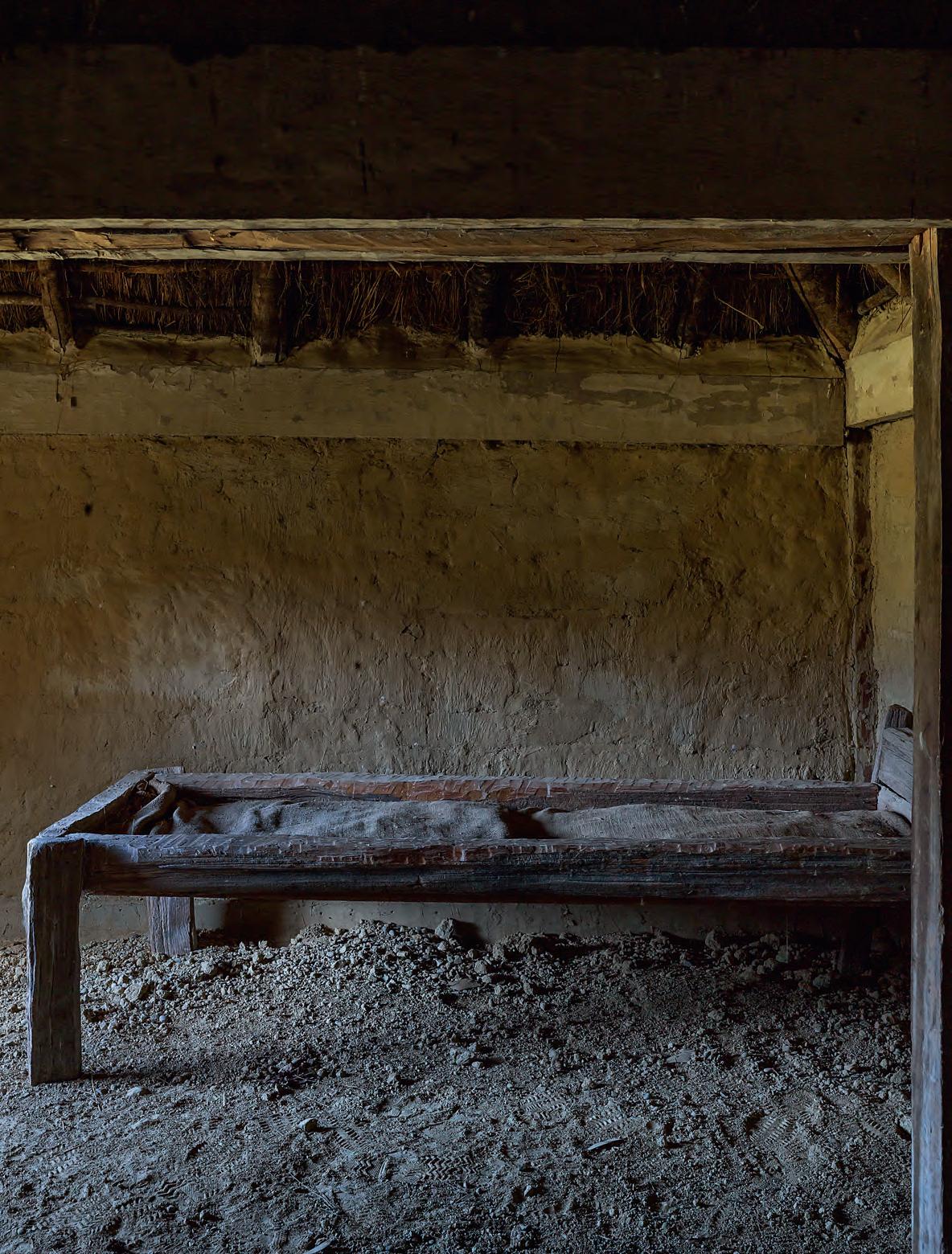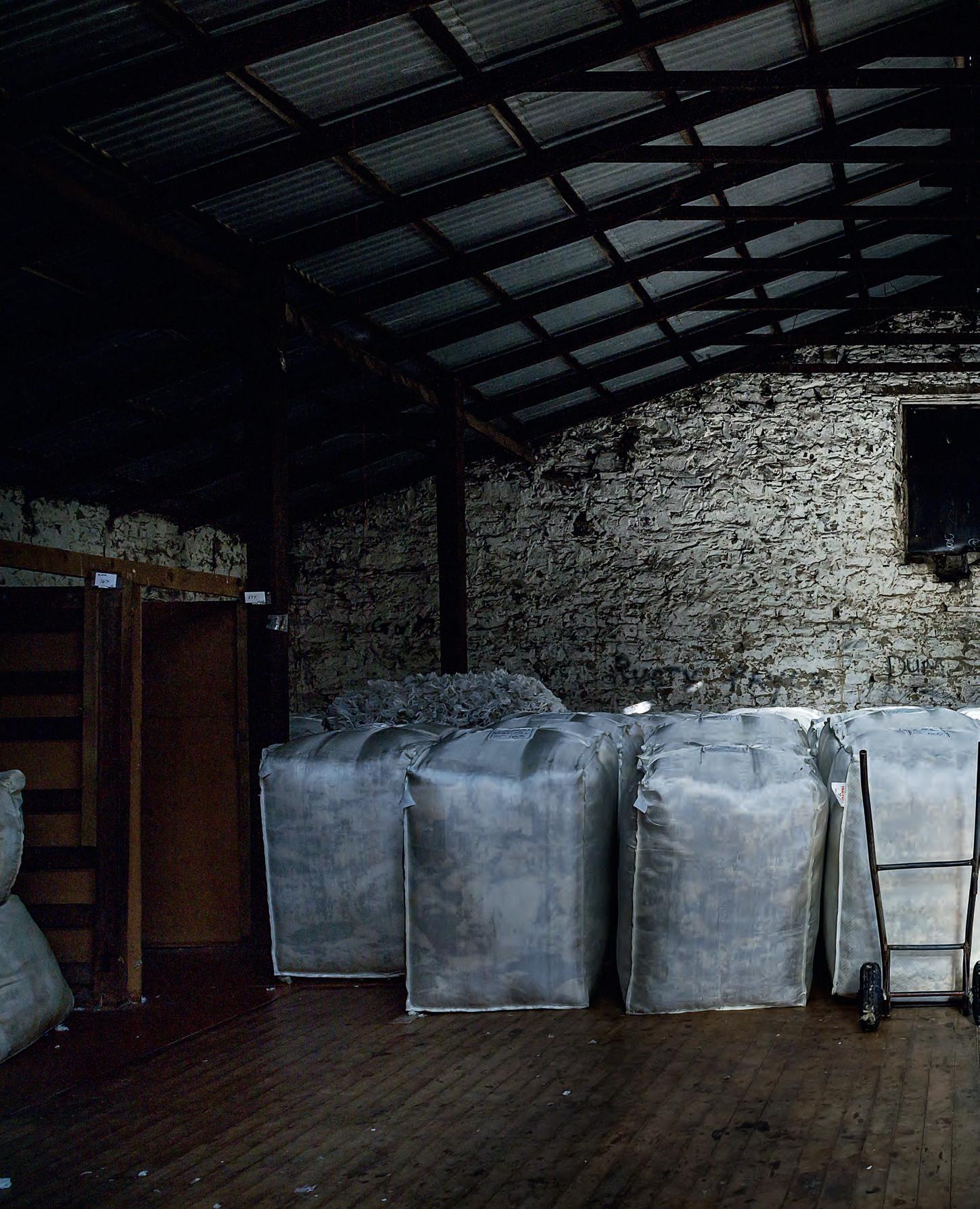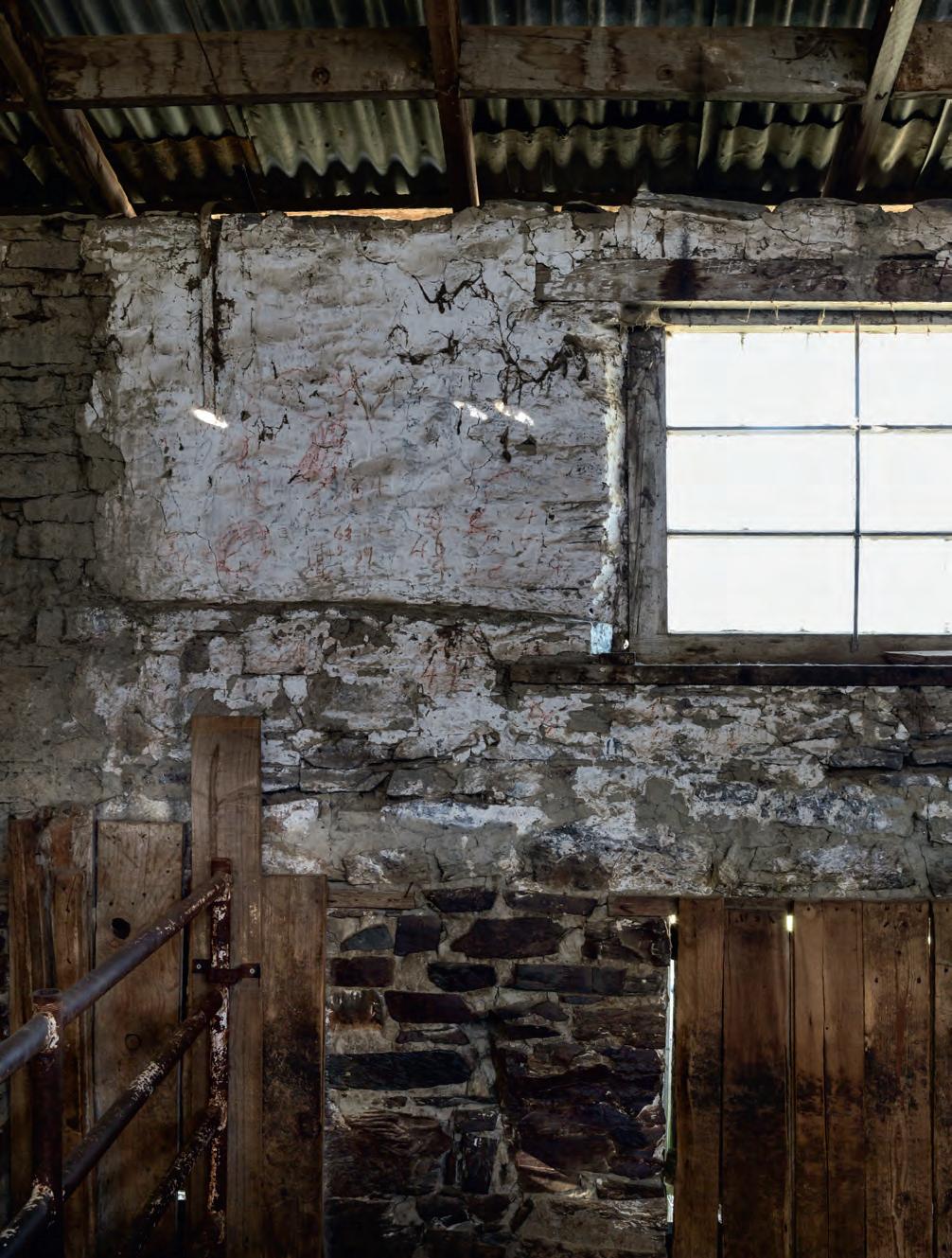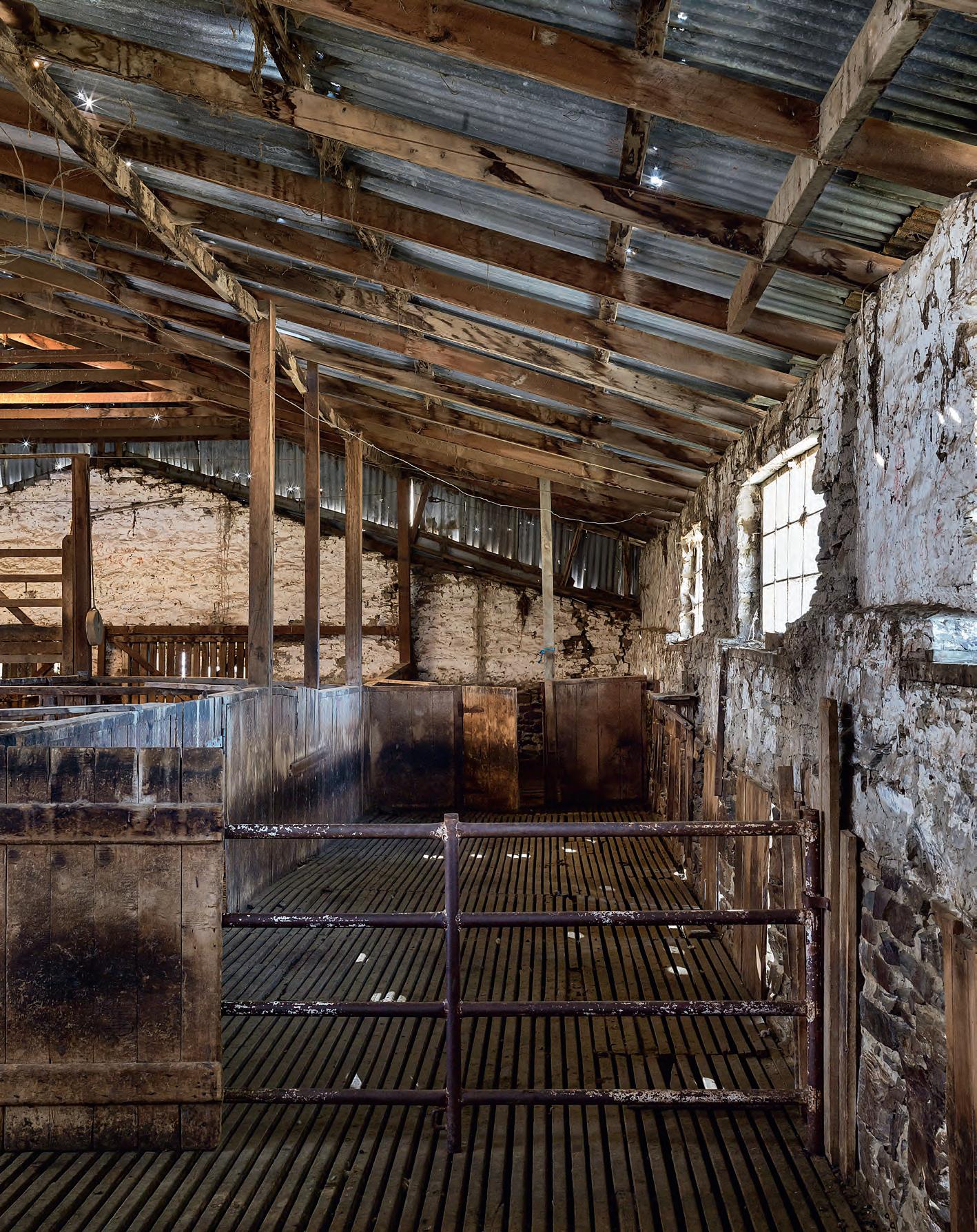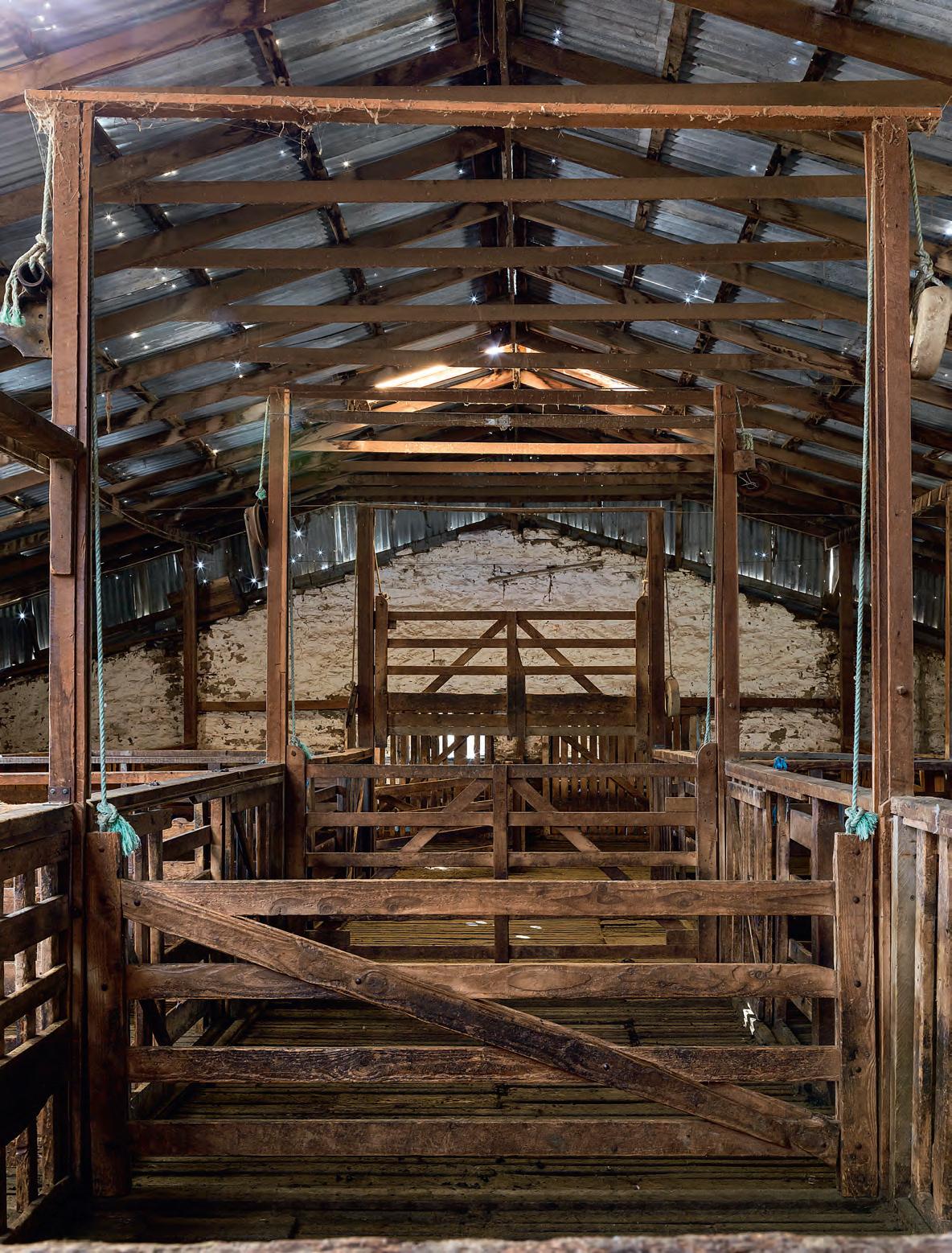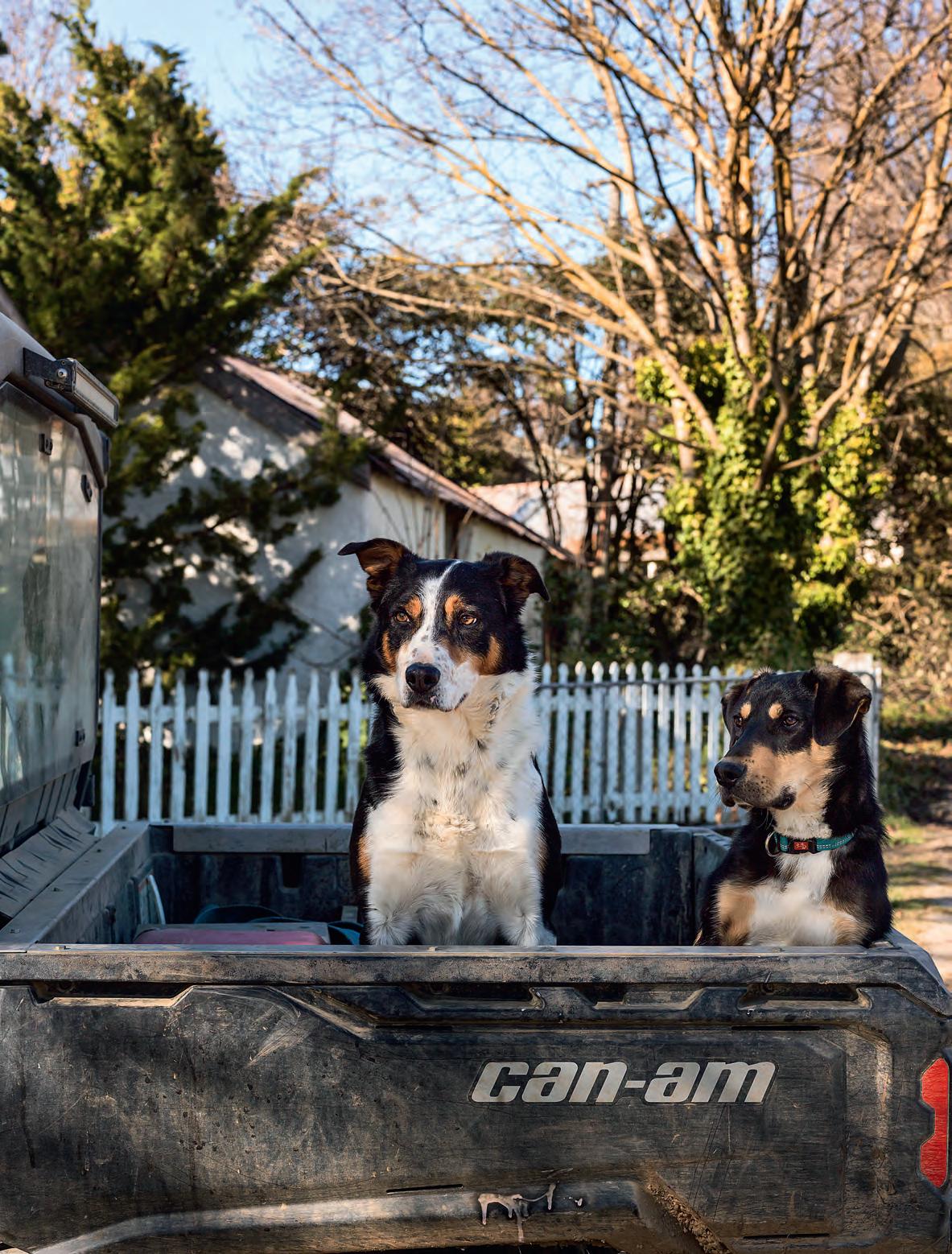Te Waimate
Along avenue of 140-year-old oaks lines the driveway that leads to Te Waimate Station and the Studholme homestead. There, on the front lawn of the house, stand four yew trees clipped into the shape of giant bells, the Te Waimate brand, planted in 1904 for the farm’s 50-year celebrations.
In 1854 two brothers, John and Michael Studholme, established Te Waimate and registered number 4 as their station brand with the Canterbury Sheep Brand Registry. A year later they changed it to the symbol of the bell. The reasons are now not clear but Michael Studholme, who bought the farm in the 1970s, suggests that his great grandfather could have been inspired by Bell’s whisky, the Scottish brand established in 1825 and whose owner’s motto was ‘the qualities of my goods speak for themselves’.
That bell and the station name were stencilled onto all Te Waimate’s wool bales and its sheep were marked with a bell after shearing. When Michael Studholme died in 1886 his obituary read ‘in the Home markets [the British wool markets] the Waimate bell brand was well known and highly appreciated’.
Michael, John and Paul Studholme, the sons of a gentleman farmer in Cumberland, immigrated to New Zealand in 1851. The brothers had bought land in Governors Bay, over the Port Hills from Christchurch, before they left England, but once they arrived they realised it was too small. Its sale helped finance their trip to the goldmines in Australia. They returned to New Zealand in 1852 determined to take up land, and spent some months walking and riding around Canterbury before deciding on the most promising area, first in Rakaia, then later in Hororata, where they bought a run known as the Terrace (see page 86).
In 1854 the brothers were ‘much struck’ by the land around Waimate and made an agreement with Ngāi Tahu rangatira Te Huruhuru to settle in the area. It was agreed that Michael would stay at Waimate and that John and Paul would remain in Hororata.
In 1858 Paul Studholme left New Zealand to live in Ireland. Over the next 20 years Michael and John acquired several properties in the North and South Islands, often in partnership with others. It was an era of vast estates held in the hands of a very few but even so their landholdings were enormous at 400,639 hectares (990,000 acres). Michael could have lived on any of it but he spent most of his life at Te Waimate.
In 1867 the Studholmes bought Coldstream Station, a 32,375-hectare (80,000-acre) property on Mid Canterbury’s east coast. When the brothers decided to dissolve their joint ownership of the stations in 1877, John took Coldstream and Michael remained at Te Waimate. However, both continued to use the brand of the bell, with variations of the design for different properties.
In the early days the Waimate district’s rolling, tussock-covered downs also had extensive areas of native bush. Tōtara were especially plentiful and the timber was in great demand for building houses in the surrounding towns. At first the timber was felled by hand, and then cut with pit saws (a two-handled saw operated vertically over a pit which cut logs lengthwise). During the 1870s circular saws, driven by steam engines, were used. A booming milling industry was developing in the district but in 1878 a bushfire devastated the local economy when it destroyed the Waimate bush along with seven sawmills and several cottages.
When they first arrived at the property the brothers built a two-room tōtara slab and sod dwelling known as The Cuddy, where Michael lived for the next six years. The Cuddy, once a little house on the edge of a forest, now stands in the grounds of the homestead, a rare example of an early settlers’ cottage. Although the design follows English conventions of wood and thatch, the materials were adapted to what was locally available: its timber slabs were cut from tōtara and lined with wattle and daub (a mix of mud and tussock). The original roof was thatched with snow grass. It still has its clay floor; the original sod chimney has been replaced with sun-dried bricks.
Two years later the Studholme brothers began work to build a twin-gabled weatherboard woolshed on a hill behind The Cuddy. Its original parts date back to 1856, and it is one of the oldest and most historically significant working sheds in New Zealand. It is built mostly of pit-sawn tōtara and kahikatea, some roof timbers are adzed, and several of the poles are entire mataī trunks. The exterior was painted with red oxide, a colour typically seen on woolsheds around the country in this period. Eighty per cent iron ore and 20 per cent oil, the paint has preservative and fire-resistant qualities.
The first roof was made from finely cut tōtara shingles that had been split with a froe and laid on top of sarking boards. Once it became available, the shingles were later covered with corrugated iron. The Lysaght iron roof has endured and remains in place today. Towards the back of the shed are the original sheep pens, whose mānuka rails have been well oiled by the wool of thousands of sheep over the years. The yards around the shed have t he original morticed tōtara rails installed in the 1850s and 1860s.
The woolshed, designed in a rectangular shape, was originally built for 22 blade shearers, with 11 stands on each side and sheep pens in the middle. It can hold around 700 sheep during shearing. In the days of blade shearing an average of 110 sheep per shearer were shorn a day, with three pressers processing around 50 bales. At its peak in 1888 there were 65,000 sheep on the station — a mix of merinos on the hill country and cross-breds on the lower pastures — and Te Waimate was producing around 1400 bales of wool annually.
As the farm became established other buildings were added, including the shearers’ quarters, granary, a two-room stockman’s cottage, and a manager’s house whose walls are insulated with packed earth. In 1860, when Michael married Effie Channon, work had begun on a 32-room wooden homestead. A fire in 1928 totally destroyed this building and nothing could be salvaged except two silver cups. In 1888 the stables building was constructed from clay bricks from nearby Makikihi. The walls of the tack room are still papered with pages from English magazines dating back to the 1870s.
At its peak production during the 1880s, 57 permanent staff were employed on the property, and this number swelled for the six weeks of shearing with the addition of shearers, sheep-os, fleece pickers, wool rollers, branders, wool classers, classers’ boys, pressers, waggoners, cooks, shepherds and the shed boss. The wheat harvest took two and a half to three months and during that time the numbers of workers employed on the station increased to 350. The great number of mouths to be fed explains how between 1500 and 2200 sheep were killed for station use each year.
Te Waimate was also known for its horses, and by the 1880s the station carried more than 300. Six four-horse teams worked the land, and a blacksmith and assistant were employed to
keep them shod and to maintain ploughs and other implements. Around 35 to 40 light horses and the equivalent number of working horses bred on Te Waimate each year were branded with a bell above a number. During the 1880s and 1890s the bell brand became well known in New Zealand, Australia and India through Te Waimate’s trade in horses. Many were sold to be tram horses in Sydney and Melbourne.
In 1875 the first Grand National steeplechase in New Zealand was held at nearby Willowbridge, on Studholme-owned land. During the 1880s the end of shearing was marked by a horse race in the paddock outside the woolshed. In 1887 the Christchurch Star reported that over 100 people had attended the Waimate Shearers’ Race Meeting, whose races included The Shearers Cup, The Woolshed Handicap and The Consolation Race, arranged by the shearers and with Mr Michael Studholme as the officiating judge.
In the 1980s, inspired by a design he had seen in Australia that made woolsheds more efficient for shearers and wool handlers, Michael Studholme installed a central raised board and five electric shearing machines. Apart from that, much of the original woolshed, with its reminders of the early days of blade shearing, remains intact. A wooden support for sharpening blades sits near a shearing stand, and on an internal post rows of holes show how the hourly shearing tally was recorded: a hole was plugged each time a sheep was shorn. The clerk, who had an office in the corner of the shed, updated the tally every hour and was responsible for paying the men. Blade shearing was replaced in the early 1900s by a four-stand Cooper shearing plant driven by a Blackstone kerosene engine. This was upgraded to a petrol engine in the 1940s and electricity was installed in the 1950s. An updated Cooper plant was used for many years until five Lister machines were installed.
An imposing Ferrier wool press with its vertical boxes, decorative details and display lettering is a striking feature in the woolshed. Invented in 1866 by Joseph Ferrier, and produced by Humble & Sons, the press was imported by the Studholmes from Geelong, Australia, as a flatpack. At least 2843 Ferrier presses were made and each has its own individual number; the Ferrier at Te Waimate is number 785. The boxes maintained the shape of the bale while it was pressed by three pressers, who handled the mechanical arm that tipped over the wool-filled top box so it could be pressed into the lower box by a wooden cap. In the wool room a squat tower was fitted to accommodate the height of the press.
The Ferrier at Te Waimate had replaced a spade press, the earliest and simplest form of pressing wool. A rectangular wool pack placed inside a hole in the floor was filled with wool and compressed with a wooden spade — a practice discontinued because it damaged the wool fibres.
The Ferrier press was succeeded by a Donalds press, a smaller wooden box press invented and manufactured in Masterton and popular from the late 1880s. Featuring a tip-over top box with two rachets on the sides, it could be operated by two people, and a further benefit was that all sides of the cap could be sewn while the bale was still in the press. Finally, the Donalds press was superseded by a more efficient and easily operated electric press. Michael Studholme is one of the few people who can operate the Ferrier today and, although it hasn’t been used for years, his son Henry, who runs the farm with him, is keen to see it working once more. Until then, it remains an object of beauty and historical significance.
Back in the 1880s, when it was overseen by Michael Studholme, the great-great-grandfather of Henry Studholme, Te Waimate ran to 40,000 hectares (98,500 acres). When he and his brothers had made the agreement with Ngāi Tahu rangatira Te Huruhuru in 1854, Te Waimate had become the earliest sheep station in the region. Te Huruhuru became the leader of Ngāi Taoka (a sub-tribe of Ngāi Tahu), and he welcomed Michael Studholme as a friend; the two established a rapport and mutual respect for each other. A memorial to honour them and the important part they played in the early history of the area was erected in the town of Waimate in 1934 on the 80th anniversary of their meeting.
Today Te Waimate is a 930-hectare (2422-acre) hill country station of rolling hills, native bush and river flats with 2500 Romdale (a Romney Perendale cross) breeding ewes and 700 cattle. Henry Studholme and his wife Katie run Te Waimate alongside Henry’s parents, Michael and Jan Studholme. Katie is from rural East Sussex and met Henry when she was working on a farm in North Canterbury. Their two young boys, Charlie and Ollie, are the sixth generation of Studholmes to grow up at Te Waimate Station.
All Te Waimate’s sheep continue to be shorn in the woolshed and, like the generations who have gone before, the current Studholmes adapt to changing markets, economic fluctuations and unpredictable weather patterns by introducing new breeds, improving irrigation and keeping up to date with pasture management. The Cuddy and the woolshed are both Category 1 historic places and continue to be valued and preserved by their custodians — the Studholme family and Heritage New Zealand Pouhere Taonga.
Page 35: Porthole door on the southern side of the woolshed. The shed’s tōtara weatherboards were milled on the property.
Pages 42 and 43: In the stables’ tack room.
Pages 36 and 37: A small mob of pregnant Romdale ewes waits to be shorn.
Pages 44 and 45: Inside The Cuddy, the home of Michael Studholme from 1854 to 1860. It was constructed with tōtara slab and cob, lined with wattle and daub, and thatched with snowgrass.
39:
corner.
Page
The shed’s smoko
Page 40: The intact historic Ferrier wool press.
Page 41: Te Waimate’s stencilled bell brand.
There is ancient Māori history in Central Otago, a place travelled through to reach pounamu sources further west, and travelled to from the east coast to hunt moa, water birds and weka, and to trap eels. A traditional route ran from the coast to the interior on the north bank of the Mata-Au Clutha River and another from Murihiku Southland, up the Mataura River, into the Nevis Valley and on to Lake Wakatipu. The Nevis Valley offered the easiest route from the Central Otago valley to the Southland plains and on to Te Anau and Manapouri.
It is probably fair to assume that the first European settlers to arrive at what is now Bannockburn knew none of this history. European settlement began near Bannockburn, in the dry heart of Central Otago, in 1858, when Kawarau Station was established by F. G. Alderson on behalf of the Scottish-based Australian and New Zealand Land Company. In 1862 he was joined by John Douglas, and together they oversaw the property until the company formally took over the lease in the 1890s.
Their timing was impeccable. In May 1861, three years after Alderson had secured the land, gold was discovered by the prospector Gabriel Read at what is now known as Gabriel’s Gully in South Otago and the Otago gold rush began. In 1862 gold was also discovered in the Cromwell Gorge and by the 1870s the population at Bannockburn had peaked at 2000. Miners worked the river flats, streams and into the valleys and gullies, building stone huts close to where they worked. The discovery of gold-carrying quartz in the Carrick Range prompted another gold rush and eventually the terraces between the Kawarau River and the foot of the Carrick Range were extensively mined.
Decades later, many of the water races the resourceful miners installed became the basis of the irrigation schemes that would allow the local runholders to grow lucerne as a feed supplement for their sheep. One of the races used by Kawarau Station today ran for 24 km, taking water from its inlet on Bannockburn Creek to the main mining area at Bannockburn.
Coal mining in Bannockburn ran alongside the gold mining and fuelled new steam-powered machinery for mining and dredging the creeks and rivers in search of gold. As individual miners panning for gold were replaced by dredging companies, sluicing began on all the gold-bearing streams, and dredges worked the edges of the Kawarau River, transforming the local landscape in the process. Mining for gold continued for the next 40 years until supplies became exhausted, and the industry went into decline after 1910. Coal mining continued up until the 1950s, primarily for domestic use.
Kawarau Station played a pivotal role in providing food for the mining community at Bannockburn and the surrounding area. Bread was cooked in the station’s bakehouse, and limited groceries and mutton were available for those who could pay. Stock were taken into the Bannockburn township each week to be killed and sold at what became known as Slaughteryard Hill, opposite the current Bannockburn Hotel.
The station was on the main route to the gold mining areas of the Carrick Range and travellers regularly called in to pick up supplies. As long as it did not interfere with farming operations, miners on station land were allowed to fence off small plots and keep their own animals. They were responsible for keeping their sites free of rabbits and when needed they were a handy source of extra labour.
More land was acquired, and at its peak Kawarau ran to a massive 85,000 hectares (210,000 acres) of high country, its boundaries extending from halfway down the Cromwell Gorge to Boundary Creek (between Gibbston and Frankton) and in the south taking in the Carrick and Cairnmuir ranges, the Nevis Valley and part of the Old Man Range. At this size it was one of the ‘big five’ stations in Central Otago, the others being Earnscleugh, Morven Hills, Moutere and Galloway stations.
‘Kawarau’ means channel between rocks, and the station is named after the deep, fastflowing Kawarau river that runs on its northern boundary. In the early years the station was isolated, and until a suspension bridge was built across the Kawarau River in 1880, linking it to Cromwell, supplies were brought in by pack horse from Clyde over the Cairnmuir Mountains.
Before the station was broken up in 1910, following the land reforms of the Liberal government, which the Australian and New Zealand Land Company had fought, there were two woolsheds on the property. The shed at Gibbston has now been converted into a winetasting venue but the homestead and woolshed in the Bannockburn valley alongside Shepherds Creek, both built in the early 1860s, are still in use. Timber was scarce and so both the rambling homestead and the Category 1 historic woolshed were built mostly of local schist.
Long and low, and built on two levels to follow the contour of the slight gradient on which it sits, the woolshed’s shallow-pitched roof is clad in the original iron — in an environment as dry as this, rust is not a worry.
The oldest, upper level of the woolshed was initially built as a 20-stand blade shearing shed, with 10 stands on each side of the outer walls. By 1867 it was reported that 16 blade shearers were shearing 36,000 sheep at Kawarau. In the years that followed, the number increased to 70,000 sheep. A machine shearing plant was installed in 1935 and the shearing stands were reduced to only three on one side. This was later added to, making up the five stands on the left side of the shed today.
The exterior schist stones are stacked and mortared, and the inside walls are lined with mud and coated with whitewash. They are etched with the names of past shearers and others; among them is the name of the station manager from the late 1800s, Frank Corson. Timeworn wooden double doors open into the wool room at the top end, where parts of the whitewashed walls have worn to reveal the stones beneath. On areas in contact with sheep the stones have been polished from the lanolin of their wool. The grated flooring is made up of removable sections that sit on low stone walls under the shed, which form the foundations. They can be lifted to clear the accumulated sheep manure. When the lower building was constructed in 1890, it created additional space for sheep — the pens could now hold 1100 — and for horses, when a stables was installed in early 1900.
The homestead with its thick stone and compacted-mud walls was initially three separate buildings, which were joined together in the early 1900s. The schist section of the house was once the men’s quarters, where farm workers stayed, and there was a bakehouse and store.
There was once little or no fencing at Kawarau and farm workers lived in outlying huts to oversee stock. One of the station’s remote schist stone huts used by shepherds, musterers and rabbiters is named Honeymoon Hut for the newly married couple who once stayed there.
Shearers were also employed as rabbiters to try to control the growing rabbit population. The serious infestation of the early 1880s reduced feed for sheep and caused a dramatic reduction in productivity. In 1884, the rabbiters’ tally was recorded as 244,000 rabbit skins and a year later there were 283,000. Skins were dried and sent to London for sale. At the peak of operations up to 50 rabbiters were working on the station.
In 1910 Kawarau Station was reduced to 4800 hectares (11,900 acres), including the land around the homestead and woolshed, but the station name was retained. After 1910 the property changed hands three times before it was bought by John Anderson in 1927. It has remained in the Anderson family ever since. John’s son Richard went into partnership with his father in 1956 and has lived in the historic homestead all his life. In 1998 Richard and his son John aquired the pastoral lease for the remnant of neighbouring Mount Difficulty, of which one block and part of another had gone into the Department of Conservation’s estate, and its flats to viticulture, when it had come up for sale. This purchase has increased the property to 9700 hectares (24,000 acres).
The Andersons have embraced new farming methods and are committed custodians of one of New Zealand’s most iconic landscapes. The station is stocked with 7500 merinos and 180 cattle — a mixed breed of Hereford, shorthorn, Santa Gertrudis and Simmental — farmed in one of the driest parts of New Zealand, with an annual rainfall of 300–400 millimetres per year. John Anderson is a keen adopter of new technologies. At Kawarau and Mount Difficulty, mustering to bring the sheep down off the high slopes for the winter months was traditionally done with men, horses and dogs. These days he uses a drone, which saves time and money. A drone can travel up to 5 kilometres and even when it is out of sight, he can track it on a tablet. It can cover in five minutes the same distance that would take a four-wheel-drive vehicle 45 minutes. Although he still uses a helicopter in some areas, the drone can get to places that are simply too challenging to reach and it can also be used to check gates and monitor the state of fences in heavy snowfalls during winter. He maintains that the sheep respond well to the drone without getting too spooked.
John has also replaced superphosphate-based fertilisers with a more environmentally friendly fish and lime fertiliser that’s spread on the flat land by truck and over the hill country by helicopter. And although it looks ancient, the woolshed has new shearing gear and is efficient to work in. But operating such an historically important building has its complications. When John Anderson installed a new beam to hold new shearing machinery a few years ago, great care had to be taken that vibrations did not disturb the stone walls with their ancient form of reinforcing.
By the 1990s viticulture was widely established in Central Otago and extensive vineyards were planted around Bannockburn. The soil type, semi-arid climate and extreme seasonal temperatures favouring the production of pinot noir grapes have made it a premium wine region. This land use has competed with pastoral farming in Central Otago, just as forestry is contesting with hill country sheep and beef farms elsewhere. To protect the future of farming at Bannockburn, Richard Anderson has covenanted the land between the Nevis Valley and the Kawarau River so that it can only ever be used for grazing.
Here, where the road wends towards the turnoff to the epic Nevis Road and onwards to the
four-wheel-drive Hawksburn Road over the Cairnmuir range and out to Clyde, the landscape looks much as it did when the first shepherds came here in the 1860s. There’s irrigation in parts, and willows line sections of the Bannockburn Creek, but the chink of glasses on winery lawns feels far away: here there’s just the soughing of the wind, the occasional bellow of cattle and bleating of sheep, a passing four-wheel-drive. Up high a hawk may circle, farm dogs may bark . . . it’s very much as it always has been.
Page 52:
Page 53:
Pages 54 and 55:
Page 56:
Page 57:
Pages 60 and 61:
Page 62:
Page 63:
and Tom.
Looking from the wool room door towards Mount Difficulty.
The board, with recently installed shearing machines.
The side entrance to the rear of the woolshed.
The killing shed at the back of the woolshed.
The Kawarau Station wool room. No one these days is quite sure who Louella was but she left a big mark.
The 16-micron merino fleece on the wool sorting table was selected for a Child Cancer Society fundraising auction.
Windows on the east side of the woolshed.
Kawarau Station dogs Whisky

